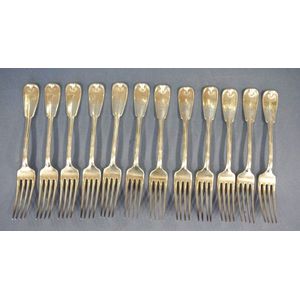Russian Imperial Silver Fork Set, 1857
You must be a subscriber, and be logged in to view price and dealer details.
Subscribe Now to view actual auction price for this item
When you subscribe, you have the option of setting the currency in which to display prices to $Au, $US, $NZ or Stg.
- Assay / Assayed - Assaying is the testing of a metal, most commonly silver and gold to determine its ingredients and quality. In Britain, once an item of silver or gold has been assayed, a mark is stamped on it, certifying its purity. Known as hallmark, it derives its name from the Guild Hall of the Goldsmiths' Company, who recieved its Charter in 1327 giving it the power to assay and mark articles of gold and silver.
- Circa - A Latin term meaning 'about', often used in the antique trade to give an approximate date for the piece, usually considered to be five years on either side of the circa year. Thus, circa 1900 means the piece was made about 1900, probably between 1895 and 1905. The expression is sometimes abbreviated to c.1900.
This item has been included into following indexes:
Visually similar items

Set of 12 Tiffany & Co sterling silver forks, fiddle, thread and shell pattern main course forks circa 1867, pattern 1871, stamped 'Tiffany & Co Sterling Pat 1871', 20 cm long, 973 grams

A Crisp set of Victorian dessert forks, London, with maker's marks for Robert Stebbings, fiddle pattern thread edged forks, hallmarked underside to terminals, silver weight 343gr. Length 18 cm

Chinese silver part fruit set, comprising of 11 knives 16.6 cm long, 11 forks, 5 teaspoons and 1 sugar spoon, impressed STERLING YCC marked (including knife blades), 780 grams approx, tested 950/1000 purity

Sterling silver Queens & Kings pattern cutlery set, (assembled), comprising of 12 main, 12 entree forks, 6 main, 6 entree forks, 6 table / soup spoons, 12 dessert spoons, 11 teaspoons, 1 basting spoon, a fruit knife and fork, with various hallmarks includi
